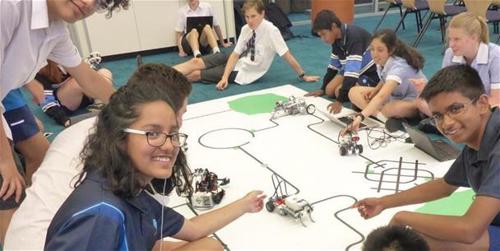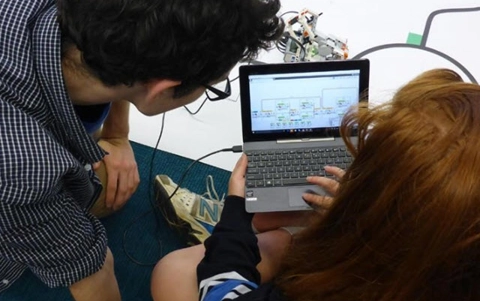John Monash Science School
The Journey To Digital Technologies
The choice between whether to make the Digital Technologies curriculum (and digital technologies in general) a standalone subject or to integrate it into other areas of the curriculum can be a difficult one. In terms of expertise of teachers, it may be that you have only one teacher who is confident in helping learners tackle the curriculum or indeed your expertise may be more widely spread. Much of what you do in terms of implementation will be dictated by your resources, timetabling and staffing. But is there a philosophical argument for one model over the other? Is it better to take an integrated approach or should we see the Digital Technologies curriculum as a subject apart?
Many would argue that the Digital Technologies curriculum is another form of literacy, a way of thinking and doing that is applicable across a range of subjects. If we look at it this way, then perhaps it would be best to take an integrated approach and cover the whole range of content descriptions in a number of subject areas or inquiries. On the other hand, perhaps discrete teaching of the skills from the curriculum is required to enable learners to use them judiciously where they see fit.
As with most things, the answer is probably somewhere in between. It is worth exploring a blended approach – where some skills are taught discretely as enablers to further learning while other skills are learned through Mathematics, Science, Art or English.
In this case study, we are going to look at how John Monash Science School (JMSS) in Melbourne is moving from a discrete course, through a hybrid model, and towards an integrated approach.
John Monash Science School, Victoria
Background
- JMSS is Victoria’s first specialist secondary school for Mathematics, Science and associated technologies.
- JMSS has a little over 600 students in Years 10, 11 and 12.
- JMSS is the result of a partnership between the Victorian Department of Education and Training, and Monash University. It has a mission to develop passionate STEM learners and to share next practice in STEM education across Victoria.
The inspiration
JMSS is a specialist science school on the grounds of a world-leading university. Founding principal, Peter Corkill, had the rare opportunity to build the school, both physically and culturally, from scratch. JMSS has the mission to develop a passion and interest in students across Victoria for STEM learning and education. Peter and his team wanted to make sure that the school curriculum was cutting edge in its content, and that it used research-based pedagogy and digital technologies to support learning.
In 2009, Peter and his team were working on the design of the school curriculum with partners from several faculties at Monash University. At one meeting, with Professor David Abramson of the Faculty of Information Technology (now Director at the Research Computing Centre at the University of Queensland) and Senior Lecturer David Albrecht, Peter and his team realised that in terms of digital technologies, they ‘did not know what they did not know’.
(Abramson and Albrecht) mounted a compelling case for the incorporation of technologies teaching in science, simply because, in their view, contemporary science research cannot happen unless technology is involved. So much experimentation in things like astrophysics through to molecular biology is not necessarily in test tubes and wet-labs anymore, it is through mathematical and computer modelling ... It was quite clear that we needed to capture some ground and skill our kids up (in digital technologies) if they were going to head into a career, let alone a university course, that was starting to champion the use of digital technologies.
– Peter Corkill, Principal, JMSS.
Peter and his team decided to introduce a compulsory Digital Technologies subject in Year 10, called Creative Studies. This subject combined digital technologies, creativity and science. With the help of the Monash University Faculty of Information Technology (including Albrecht and Professor Bernd Meyer), units of learning were developed around coding simulations within the context of simulations. One such unit, co-developed and taught by Neil Carmona-Vickery, Head of E-learning and IT at JMSS, was the creation of bushfire simulations using block-based coding. Neil and his team of teachers took a project-based, constructivist approach to these units, developing units that were accessible to all learners and still able to stretch those who already had experience of coding. As this was a brand new subject, the team of teachers had varying expertise in terms of technology, pedagogy and content knowledge, and Neil supported the teachers’ professional learning to help them develop in all areas of the TPaCK model. (Find out more about the TPCK model.)
Developing teacher competence
There are creative ways to improve teacher competence in digital technology. There are also effective ways to integrate the Digital Technologies curriculum. Some of these are illustrated in the School implementation section of the Digital Technologies Hub. Peter also gives us a timely reminder of one of our most valuable resources: the learners in our schools.
Not every English teacher and Maths teacher needs to code, but we have used our professional learning time to develop teacher confidence in digital technologies. There is however a scarcity of teachers in the system who do have an expertise in digital technologies ... Our greatest resource can be our alumni, we still have access to them to work with our students in co-curricular time, but why not use them to train teachers around digital technologies. I equate this to the Apple Store in Chadstone; 40 young people in blue t-shirts who probably know more about digital technologies, with the greatest respect, than the majority of our teaching workforce. Get a couple of university students in, full of enthusiasm, and let them support your teachers and help to further develop a workforce.
Iteration
As with all innovation, there was a process of iteration. Creative Studies was rebranded as Emerging Technologies, with a shift towards integrating elements of mathematics, science, art and IT, along with robotics. New units were developed under the following themes:
- Algorithmic art: using mathematical principles and block-based coding to create artworks and virtual worlds.
- Virtual worlds: using block-based coding to develop simulations of natural systems in a virtual simulation or robot-based simulation.

At the Year 10 induction camp in 2012, Peter spoke to two new students, Ashley and Konrad, who showed him apps they had already developed. There was a realisation that a growing number of students were coming to school with already highly developed algorithmic and computational thinking skills and coding expertise. Neil and his team worked hard to differentiate the Emerging Technologies course to allow these students to explore and develop while supporting those students new to algorithmic and computational thinking.
At the same time, it was evident that the use of digital technologies in learning across the school was burgeoning. Students were creating digital simulations, and undertaking robotic modelling and algorithmic thinking in subjects ranging from Mathematics to extended experimental investigation in Science.
The school’s approach to VCE IT shifted towards project-based learning, which resulted in real-world innovations such as DolphiNote, an app designed by three Year 11 students that is now used in the real world to monitor the dolphin and fur seal populations in Port Phillip Bay in Victoria. (Find out more about DolphiNote.)
Wednesday afternoon co-curricular robotics courses were developed, and VCE IT blossomed with each project. The projects had real-world applications, intended for authentic audiences. Luke Bohni, Head of Mathematics at JMSS, helped develop a HESS (Higher Education Scored Study) in Algorithmics, which allowed students to deeply explore the nexus of mathematics and computational thinking. JMSS also developed a further partnership with Monash University to provide Emerging Sciences Victoria, a virtual science school aimed at regional and rural students, with heavy emphasis on digital technology use. (View a full case study.)
From organic to integrated
In essence, a discrete Digital Technologies subject was organically growing and becoming part of other curriculum areas, but that integration was still not as cohesive and coherent as the school leadership wanted.
The school has decided to make a structural change and merge the science faculty with the IT faculty over the next two years with the aim of developing a truly integrated approach to digital technologies.
The school recognises that computational and algorithmic thinking are key in scientific research, and that technology is the enabler that allows their learners to capture and analyse data, find problems and design solutions. For example, the school is looking at how to integrate coding into chemistry in order to start breaking down the siloed nature of the curriculum.
Peter hopes that in the future, the Digital Technologies curriculum will give way to an approach where digital technologies are a core part of all learning, providing great preparation for all learners in terms of the careers they wish to follow.

